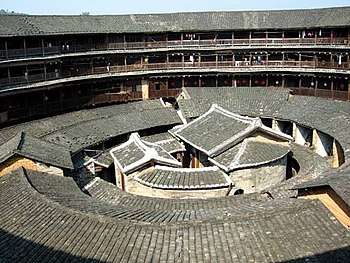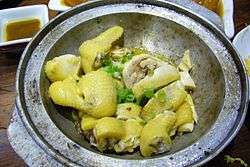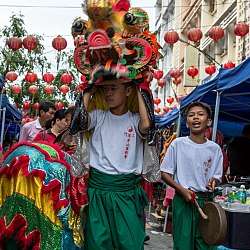Hakka culture

Hakka culture (Chinese: 客家文化) refers to the culture created by Hakka people, a Han Chinese subgroup, across Asia. It encompasses the shared language, various art forms, food culture, folklore, and traditional customs. Hakka culture stemmed from the culture of Ancient Han Chinese, who migrated from China's central plain to what is modern day's Southern China during the 6th to 13th century, and intermixed with local non-Han ethnic groups such as the Miao people.[1] It has also been influenced by the cultures of surrounding Han Chinese groups, such as the Cantonese and the Hoklo. Having historically lived in the mountains of Southern China and being minority groups in many of the surrounding Chinese provinces, Hakka have developed a culture characterized by reservedness, stability, and frugality.[2][3]
| Wikimedia Commons has media related to Hakka culture. |
Language
Architecture
Hakka walled village
Hokkien earthen building
Horn House
Arts
Hakka hill song
Hakka opera
Hakkapop
Hakkapop is a genre of Hakka pop music made primarily in Taiwan, China, Indonesia and Malaysia.
Cuisine

Traditionally engaging in large amount of physical labor, Hakka people favor salty food and marinated vegetables that enable them to maintain their stamina.
Martial arts
The Hakka community is a source for a variety of martial arts including Southern Praying Mantis, Bak Mei and Southern Dragon Kung Fu.
Women
Historically, Hakka women did not bind their feet when the practice was commonplace in China.[4]
Religion
The religious practices of Hakka people are largely similar to those of other Han Chinese. Ancestor veneration is the primary form of religious expression[5]. One distinctively Hakka religious practice involves the worship of dragon deities[6].
Hakka Taoism
Hakka spirit
Hakka spirit refers to the Hakka people's spirit of endurance, diligence, and bravery in exploring new lands.[7]
See also

References
- ↑ 客家文化源于河洛文化
- ↑ Jian-xin, Z. H. O. U. (2005). Ethnic Identity, Culture Consciousness and Hakka Culture [J]. Journal of Guangxi University For Nationalities (Philosophy and Social Science Edition), 2.
- ↑ Deng-qiu, C. A. I. (2004). On Pluralism of the Formation of the Hakka Culture [J]. Journal of Sanming College, 3, 015.
- ↑ Davis, Edward L. (2005). Encyclopedia of Contemporary Chinese Culture. London: Routledge. p. 333. ISBN 9780415241298.
- ↑ Lozada, Eriberto (2005). Ember, Carol R.; Ember, Melvin; Skoggard, Ian, eds. Encyclopedia of Diasporas: Immigrant and Refugee Cultures Around the World. 2. Dordrecht, Netherlands: Springer Science & Business Media. pp. 92–103. ISBN 9780306483219.
- ↑ 客家夥房的土地龍神
- ↑ The Hakka Spirit